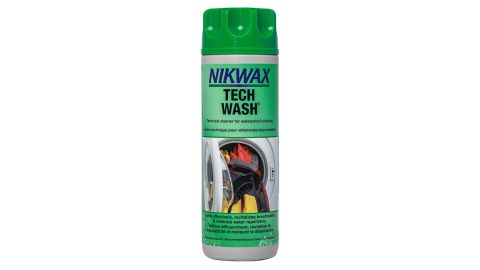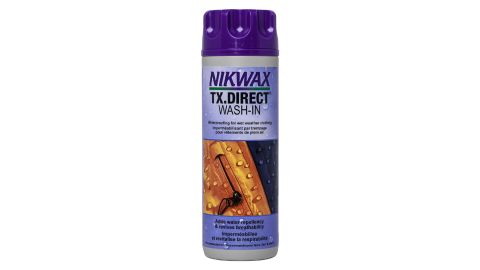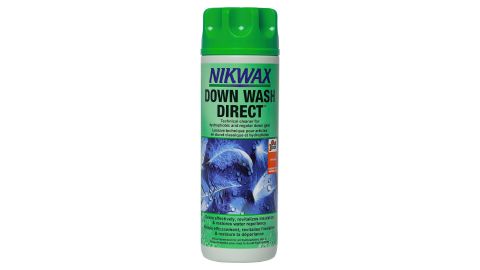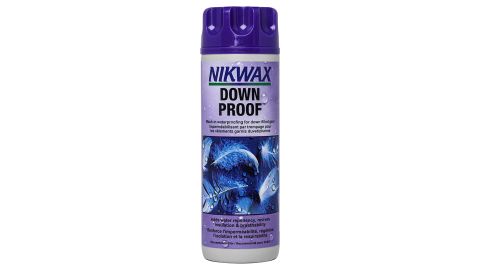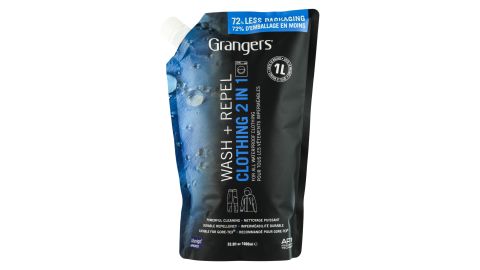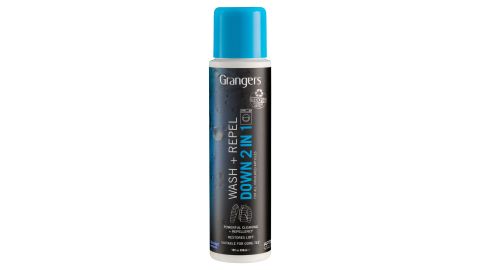[ad_1]
Purchasing outdoor gear, from hiking gear and camping equipment to outdoor furniture, is a huge investment. Not only does it take a lot of time to research what products to buy, but it also requires proper cleaning and care to make sure your outdoor gear lasts as long as possible — or even a lifetime if you do it right.
Washing and repairing the gear you own is important for the longevity of your equipment. It’s also an essential part of living a more sustainable outdoor lifestyle by keeping unnecessary waste out of the landfill. We interviewed several gear washing and gear care experts on how to clean your outdoor gear the right way.
Their insights cover everything from when to know your gear is ready for a wash or re-treatment to the products that will help give your outdoor gear a new life with a good cleaning.
We’ve shared advice on more sustainable ways to wash your laundry, like making your own DIY laundry products or purchasing a detergent made with fewer harmful chemicals. The same is true for outdoor gear and equipment. Anabelle McLean, founder and owner of Gear Washers, a Denver-based outdoor and technical gear restoring company, says caring for your outdoor gear is really about caring for our planet. “I want to emphasize that the conversation should really be about why we should care about gear care,” says McLean. “Why are we even looking to wash something instead of buying new? At Gear Washers, that’s what it’s all about: it’s not really how we do it, it’s why we do it.”
Cleaning your dirty gear and repairing damaged products instead of trashing them plays an essential role in keeping products out of the waste stream. The EPA estimates more than 17 million tons of textile waste enters the landfill each year. That doesn’t even account for plastics, rubber and other non-biodegradable materials found in our outdoor gear.
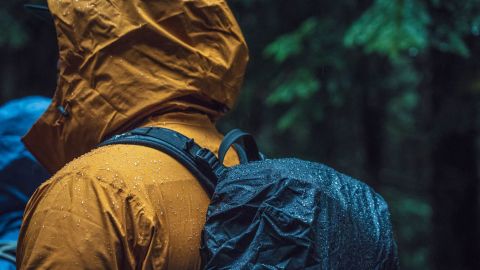
“As consumers, especially in America, we’re more concerned with how we look, the fashion trends and color schemes than buying gear to keep long term,” said McLean. “We need to shift our mind frame around not just having a piece of gear that looks really cool for one season or thinking we need to get rid of something because you spilled something on it.”
With the proper preventative care and maintenance, gear washing experts say gear can (and should) last year over year, if not a lifetime. Geoffrey Allred, client service manager at IDFL Laboratory and Institute, a global auditing, testing and accrediting lab for filled textiles, says, when taken care of properly, products made of natural materials, like down, will turn into some of the longest-lasting gear you’ll own.
“If you take care of [your down jacket] the right way, the down inside will outlast the fabric,” said Allred. “It’s more than likely the fabric will start to fall apart and wear down faster than the down will if you give it the proper care it needs. And then, if you’re taking care of the fabric the right way too, theoretically, down jackets can be generational products.”
Can’t remember the last time you washed your gear, if at all? Then it’s probably time to give that down jacket in your closet or sleeping bag in the basement a good cleaning. By doing so, your gear will both perform better and live the long life it deserves.
How often you wash and re-treat your down and waterproof outdoor gear really depends on how much you wear it. “I always say to wash your gear based on how often you’re using it,” says McLean. “If you’re camping every weekend in the summer, I would recommend washing your sleeping bag at least once in the middle of the season and then definitely at the end of the season before you store it for the winter.”
Other telltale signs of gear in need of washing are potent odors, visible dirt and grime, or oils built up on the surface of the jacket, sleeping bag or clothing fabric. Haley Huggins, manager at Rainy Pass Repair, a Seattle-based outdoor gear and apparel repair shop, says visible oils and dirt on down jackets and sleeping bags will ultimately impact the performance of the goose or duck feathers inside.
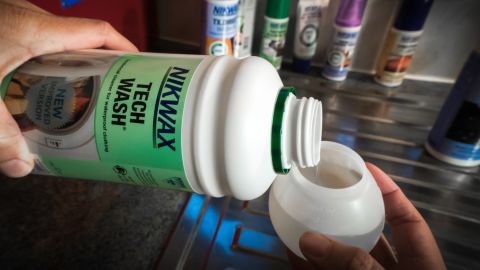
“The main thing to look out for is keeping body oils off of the external fabric on a down jacket or sleeping bag because that will wreak havoc on the feathers themselves,” says Huggins. “When you start seeing oil stains, if the fabric feels greasy, or if you start to feel big clumps of down in the jacket or sleeping bag baffles, that’s a sign that you should definitely do something quick.”
As soon as you notice this type of wear and tear, Huggins recommends using a downwash to help pull oils out, remove odors and re-fluff the down. If you wait too long to wash your down gear after clumping and oil build-up, Huggins says your down gear may reach “a point of no return.”
Standard use, as well as oil and dirt build-up on jacket, shell, sleeping bag and raincoat fabric impacts the hydrophobic performance by wearing away the gear’s durable water repellent (DWR) treatment. DWR treatment is often used on waterproof or water-resistant gear and even on some down filling, like DownTek. How long DWR-treated gear will repel water depends on the level of use. The more often you use your DWR gear, the more frequently you will need to reapply a waterproofing treatment. Additionally, repeated rubbing of a backpack on top of a shell jacket or down coat, or abrasion against a rocky surface or forest foliage, can also deteriorate a piece of gear’s DWR coating.
“Specifically for waterproof gear, you would start to feel water coming in shoulders, where the rain would be hitting you,” says Huggins. “If you can feel that water is not rolling off or wicking away, or if it’s soaking into the fabric, then you know it’s time for a DWR treatment.”
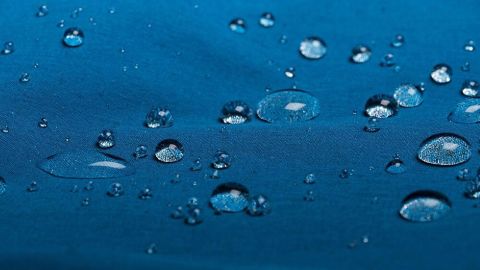
Lack of DWR or waterproofing treatment combined with a build-up of mud, sweat and dirt from the trail can turn into an even bigger recipe for disaster. “Dirt, by nature, attracts water — so if you have any patches of dirt or grime around the high touch areas of your jacket, you will automatically attract more water,” says McClean.
McLean recommends trying a simple at-home water repellency test to see if it’s time to re-treat your DWR-coated gear. “You can test the water repellency of your jacket at home with a simple test: Spray a little bit of water on your jacket using a spray bottle,” she says. “If it starts to soak in or spread on the front of your coat, it’s time to re-waterproof. If the water beads on the surface of your jacket, then the waterproofing on your jacket is fine for a while longer.”
One of the most important steps in washing your outdoor gear is choosing the right detergent. You don’t want to make the mistake of choosing any kind of standard laundry detergent, instead, you want to purchase detergent or treatment products made specifically for washing outdoor and technical gear.
“When you’re washing outdoor gear, it’s important to do an initial wash with a technical gear wash,” says Huggins. She warns that using regular laundry detergents like Tide or Gain are chock-full of harsh chemicals that can cause problems with technical gear fabric. “A lot of traditional detergents have scented chemicals that will damage your gear’s fabric,” she says. “At Rainy Pass Repair, we use Nikwax Tech Wash because it’s a very gentle detergent, it’s scent free and it’s specifically made for technical gear.”
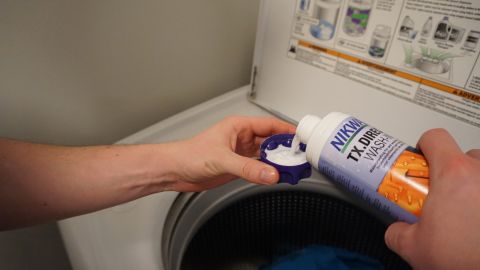
McClean seconds this sentiment and argues that outdoor gear-specific detergents tend to be more eco-friendly than your average household laundry detergent. “Nikwax is so wonderful because they’ve been making incredibly sustainable products for decades. Their products are PFC-free, VOC-free, water-based and biodegradable,” adds McClean. “Choosing sustainable products to wash our gear is the best thing we can do if we’re using a water-based washing system.”
Most outdoor gear wash you can pour directly into your washing machine’s detergent drawer or clean your gear by hand with a spot treatment. It’s always important to follow the care instructions on your gear and carefully read the back of the detergent or gear treatment bottle to fully understand how to use the product on your gear.
Nikwax’s all-purpose technical gear wash helps revitalize the water repellency and breathability of waterproof gear — from rain jackets and shells to pants and ski clothing. Apply by hand or use in your washing machine to enhance the performance of your waterproof and water-repellant gear, which will help keep you warmer and drier.
A high-performance gear waterproofer that can be used to re-treat your outdoor gear by hand or in the washing machine. TX.Direct is a wash-in waterproofing treatment for wet-weather clothing that adds water repellency and revives breathability without needing to tumble dry. This product is ideal for delicate fabrics, Gore-Tex, eVent, other waterproof fabric, backpacks and gear that can’t go in the dryer.
A technical gear cleaner made to clean and revitalize regular and DWR-treated down gear. Nikwax Down Wash Direct removes grime, dirt and body oils that build up in down filling over time. It also cleans the insulation and restores the DWR. This wash should be used before treating your outdoor gear with an additional down re-treatment solution.
When feathers inside down jackets and sleeping bags get wet, they lose their ability to trap in heat and keep you warm. Nikwax’s Down Proof wash-in waterproofing solution was designed to treat both the outer fabric and down filling with DWR while maintaining your jacket, sleeping bag or other gear’s insulation and breathability.
Tent and Gear SolarProof is an easy-to-use spray-on waterproofing and UV ray blocker for synthetic tents, backpacks and outdoor furniture. SolarProof adds water repellency, increases the durability of synthetic fabrics and protects against UV deterioration.
An all-purpose technical wash that promises to keep your gear clean and dry by removing residue build-up and restoring water repellency. Granger’s new concentrated formula gives you 12 washes instead of six — doubling the number of washes you’ll get from the bottle.
This 2-in-1 wash saves you time and energy by cleaning your clothes and adding durable water repellency to your gear at the same time. An all-purpose technical gear wash that’s made to keep your gear clean, breathable and dry without the hassle of multiple treatments.
The same 2-in-1, time-saving quality of Grangers Wash + Repel clothing wash — but made specifically for down gear. In just one wash cycle, you can use this down-friendly wash to restore both natural or synthetic down sleeping bags, jackets or apparel.
After selecting the appropriate detergent or treatment product, it’s time to wash your outdoor gear either by hand or in a washing machine. All outdoor gear can be hand-washed while others may benefit from a machine wash cycle to clean and restore it to a like-new state (especially super dirty gear). If you do throw your gear in the washing machine, try to keep the loads small and avoid center agitators, as Mclean says they can tangle or even shred your gear.
“When you when you take [care of your gear] the right way they can last a lifetime — and without diminishing the attributes and the reasons you actually purchased and paid for them,” says Allred.
DWR-treated jackets or shells in need of re-waterproofing must be washed with waterproof-specific technical gear wash. You can either purchase a wash-in waterproof treatment, like the Nikwax TX.Direct Wash-In or a spray-on waterproof treatment, like the Nikwax TX.Direct Spray-On.

“You always want your garments to still be wet when applying a waterproof or DWR treatment,” says Huggins. “After washing your garment with a technical wash, you would then put it back in the washing machine with a wash-in waterproofing treatment and run a cycle with that, or you can use a spray-on treatment and let it air dry.”
Make sure to check the interior and exterior pockets of your jackets (waterproof, synthetic and down) to remove all items inside before washing and zip closed before washing. Uncinch any elastic drawstrings around the hood or waistline of the jacket too.
How to keep synthetic jackets and garments clean
Most synthetic jackets and garments can be treated with a standard technical gear wash, like the Grangers Performance Wash, either by hand or in the washing machine. Check the care instruction label on the inside of the jacket to make sure the textiles used in the jacket are washing machine compatible.
For synthetic gear that has a waterproof or hydrophobic treatment like DWR, consider using a reproofing product like Grangers Wash + Repel Clothing 2-in-1 Wash or Nikwax TX.Direct Wash-In to both wash and revive the jacket or garment’s water repellency.
Never put more than two down jackets in a washing machine at a time. This will help you avoid uneven distribution of detergent and prevent unwashed soaps or treatments from remaining in the fabric and down filling.

If the care label allows, tumble dry according to the manufacturer’s recommendations on a low setting until the down separates within the baffles of the piece of gear. You can also tease apart any clumps of down before drying, or during and after drying, to help restore the loft of the down fill and help the jacket dry more efficiently. Down jackets may take multiple drying cycles to reach full loft and completely dry out the down filling.
It’s important to use an agitator, like a few clean tennis balls or wool dryer balls, during the tumble dry cycle. This will help re-fluff the down filling to its original loft.
How to keep sleeping bags and quilts clean
Sleeping bags and quilts are best washed in an industrial-sized washing machine or even in a bathtub. It’s important to uncinch any elastic drawstrings and zip the bag completely to prevent the edges of the sleeping bag from getting tangled inside the washing machine. When washing down sleeping bags or quilts, make sure to use a down-friendly detergent, like Nikwax Down Wash Direct or a comparable product.
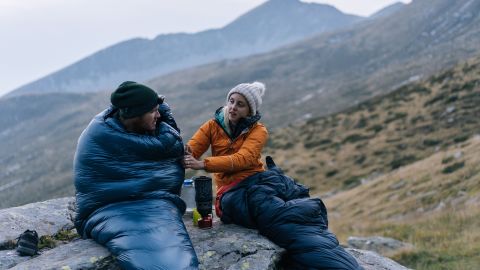
Follow a similar tumble dry process for sleeping bags and quilts as your down jackets. Tumble dry based on the directions from the manufacturer’s care label and never dry sleeping bags on a high heat setting. Similar to down jackets, it’s important to use wool dryer balls or another agitator to assist in re-fluffing the down filling.
The structural quality and waterproof protection of synthetic fabrics on tents, like polyester and nylon, can diminish over time due to UV rays, extreme weather and temperatures and drying out. By taking preventative measures during your tent’s lifetime to replenish waterproofing and treat it with UV protection, your tent will not only perform better but also live a much longer life.
You can spot-treat and wash your camping tents by hand when it has visible dirt and mud on the outside walls, rainfly or base tent. Or you can also coat your tent with a UV treatment, like Nikwax’s Tent and Gear SolarProof, to help increase fabric strength and protects against UV deterioration with products
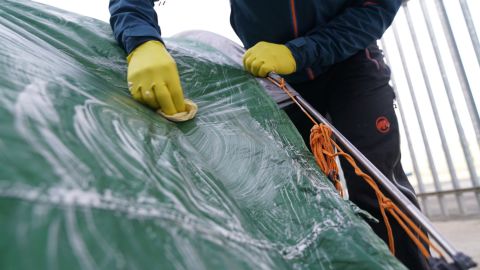
“You can even do a UV treatment on a brand new tent as well because most tents on the market aren’t going to have UV protection out of the box,” says McClean. “This will help maintain the strength of your tent for much longer than without it.”
McClean warns that if people wash their own tents at home instead of working with a service like Gear Washers, they should clean and treat the tent by hand. “Do not put them in the washing machine,” McClean warns, as most tent fabric is too fragile and machine washing puts them at risk of tangling and tearing.
For gear too delicate to go into the machine dryer simply air dry in a climate-controlled room on a foldable drying rack or on hangers. Thin synthetics, ultra-light taffeta and wool clothes are products you should especially be careful with when drying, and most often, should be dried in the open air instead of an electric or gas-powered dryer. Gear treated with spray-on waterproofing treatment should also be air dried. After spraying the treatment on wet garments and gear, leave these items out to dry.
“Down-specific gear like jackets and sleeping bags require machine drying,” says McClean, “No amount of air drying will get those down clumps to break apart.” Before throwing your down gear into the dryer, pull apart clumps of down in the baffles. This will help the fill loft much easier and dry more efficiently.
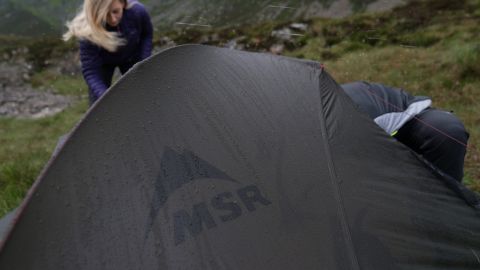
Most outdoor gear should be dried on your dryer’s lowest setting and/or a delicate-friendly drying cycle. And remember to use wool dryer balls or tennis balls to help re-fluff and loft your down gear. “You also want lots of room for tumbling inside your dryer — less is more,” says Huggins. “And you definitely don’t want to put too many pieces of gear in there because they will get all tangled together.”
Our experts also highly recommend reading the care instruction label before putting any of your outdoor gear into a machine dryer to make sure it’s compatible and set to the proper setting. However, Allred notes that most outdoor gear care labels speak to the outer fabric of the gear, not the inner filling.
“The testing that goes into creating a care label is pretty rigorous and the ones that you see most commonly are tried and true,” explains Allred. “Because most outdoor gear and products are made with polyester, nylon, cotton and other synthetic fabric shells, most come with a baseline care label with clear instructions.” Just be sure to be mindful of your gear’s filling when reading the label, as its care might be different than that of the outer fabric.
Luckily, he says when it comes to down products, it’s not as complicated. Allred recommends simply washing, drying and treating your natural fiber-filled gear (aka goose and duck feathers) by following the care instructions on your technical gear wash.
[ad_2]
Source link


